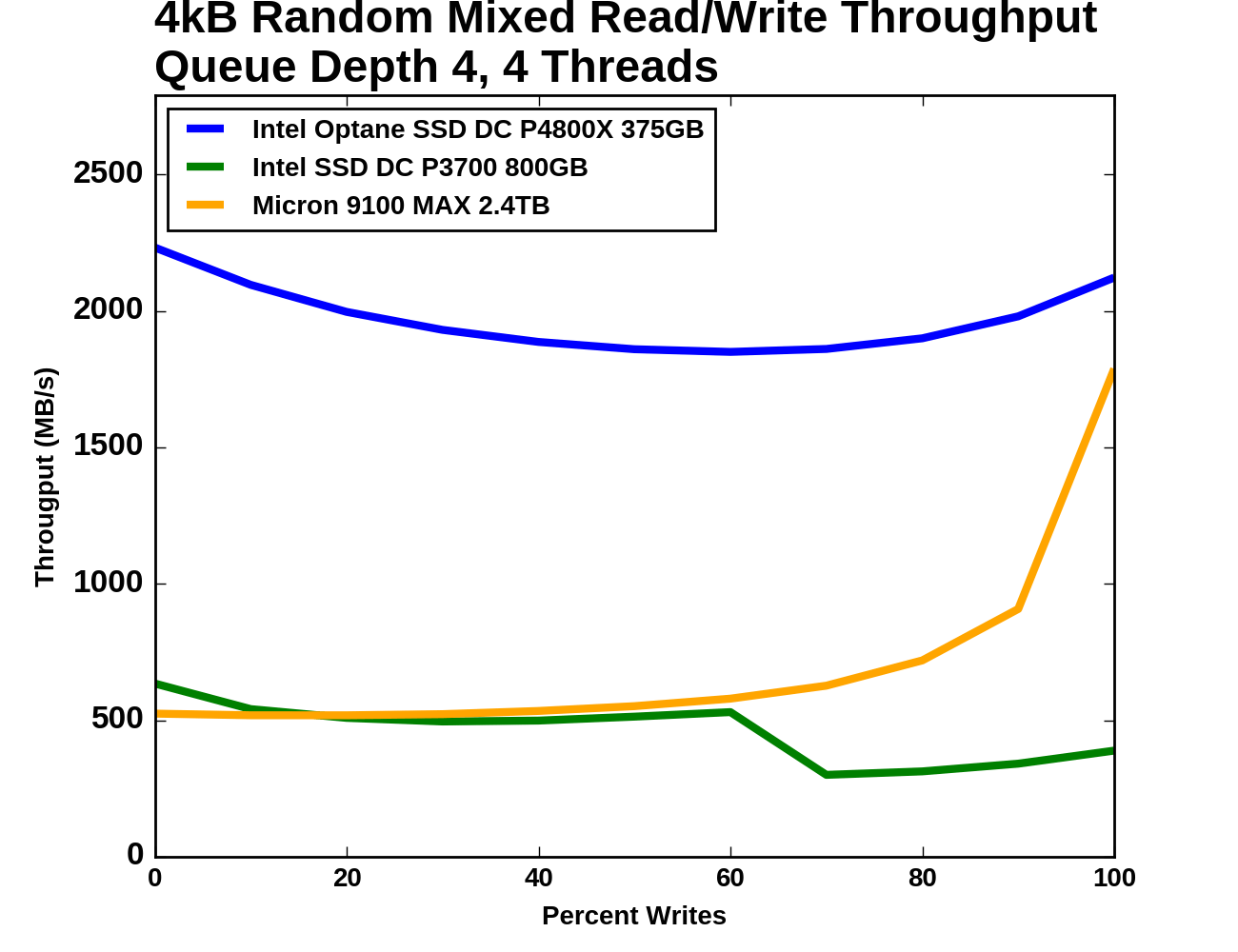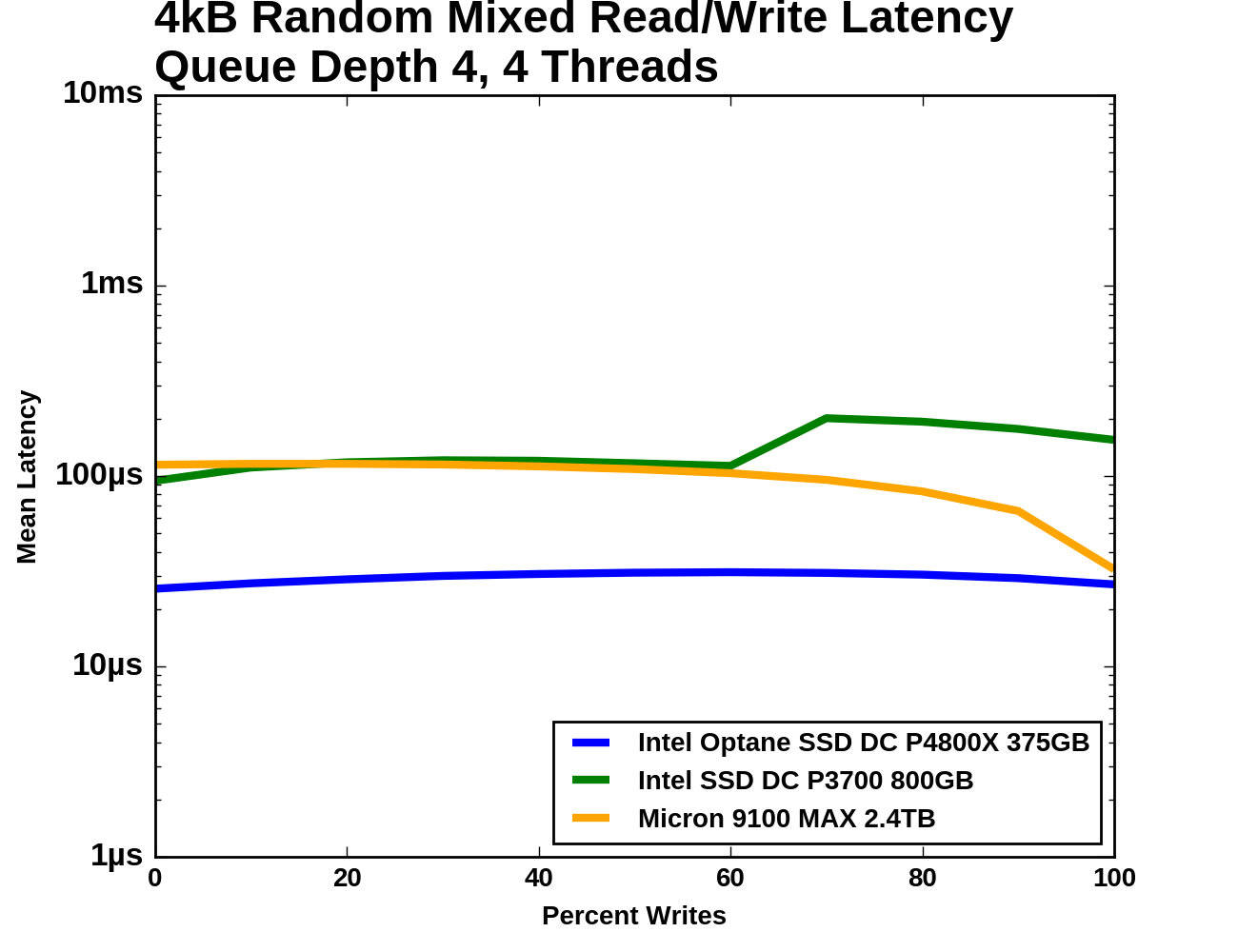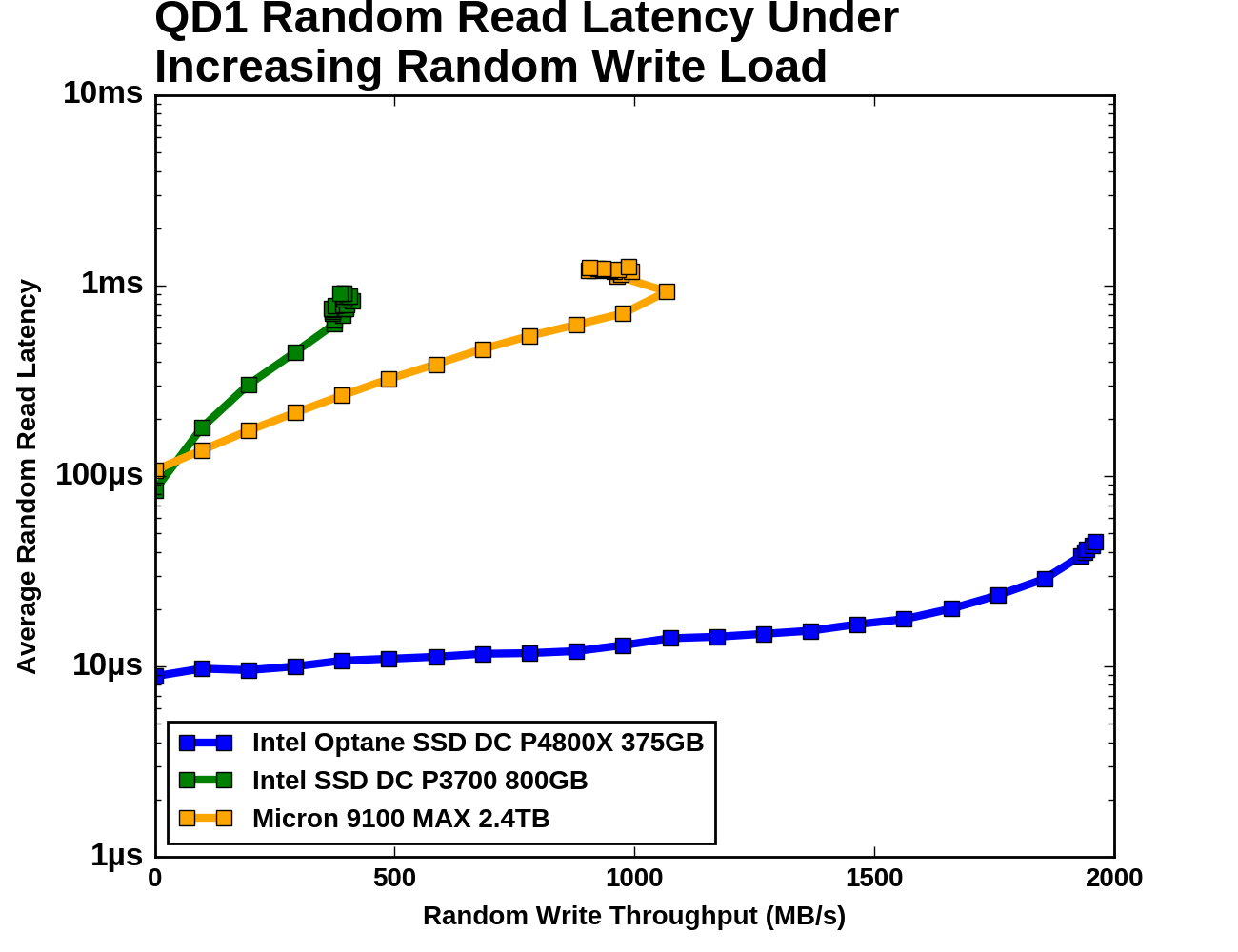The Intel Optane SSD DC P4800X (375GB) Review: Testing 3D XPoint Performance
by Billy Tallis on April 20, 2017 12:00 PM ESTMixed Read/Write Performance
Workloads consisting of a mix of reads and writes can be particularly challenging for flash based SSDs. When a write operation interrupts a string of reads, it will block access to at least one flash chip for a period of time that is substantially longer than a read operation takes. This hurts the latency of any read operations that were waiting on that chip, and with enough write operations throughput can be severely impacted. If the write command triggers an erase operation on one or more flash chips, the traffic jam is many times worse.
The occasional read interrupting a string of write commands doesn't necessarily cause much of a backlog, because writes are usually buffered by the controller anyways. But depending on how much unwritten data the controller is willing to buffer and for how long, a burst of reads could force the drive to begin flushing outstanding writes before they've all been coalesced into optimal sized writes.
The effect of a read still applies to the Optane SSD's 3D XPoint memory, but with greatly reduced severity. Whether a block of reads coming in has an effect depends on how the Optane SSD's controller manages the 3D XPoint memory.
Queue Depth 4
Our first mixed workload test is an extension of what Intel describes in their specifications for throughput of mixed workloads. A total queue depth of 16 is achieved using four worker threads, each performing a mix of random reads and random writes. Instead of just testing a 70% read mixture, the full range from pure reads to pure writes is tested at 10% increments.
 |
|||||||||
| Vertical Axis units: | IOPS | MB/s | |||||||
The Optane SSD's throughput does indeed show the bathtub curve shape that is common for this sort of mixed workload test, but the sides are quite shallow and the minimum (at 40% reads/60% writes) is still 83% of the peak throughput (which occurs with the all-reads workload). While the Optane SSD is operating near 2GB/s the flash SSDs spend most of the test only slightly above 500MB/s. When the portion of writes increases to 70%, the two flash SSDs begin to diverge: the Intel P3700 loses almost half its throughput and only recovers a little of it during the remainder of the test, while the Micron 9100 begins to accelerate and comes much closer to the Optane SSD's level of performance.
 |
|||||||||
| Mean | Median | 99th Percentile | 99.999th Percentile | ||||||
The median latency curves for the two flash SSDs show a substantial drop when the median operation switches from a read to a cacheable write. The P3700's median latency even briefly drops below that of the Optane SSD, but then the Optane SSD is handling several times the throughput. The 99th and 99.999th percentile latencies for the Optane SSD are relatively flat after jumping a bit when writes are first introduced to the mix. The flash SSDs have far higher 99th and 99.999th percentile latencies through the middle of the test, but much fewer outliers during the pure read and pure write phases.
Adding Writes to a Drive that is Reading
The next mixed workload test takes a different approach and is loosely based on the Aerospike Certification Tool. The read workload is constant throughout the test: a single thread performing 4kB random reads at QD1. Threads performing 4kB random writes at QD1 and throttled to 100MB/s are added to the mix until the drive's throughput is saturated. As the write workload gets heavier, the random read throughput will drop and the read latency will increase.
The three SSDs have very different capacity for random write throughput: the Intel P3700 tops out around 400MB/s, the Micron 9100 can sustain 1GB/s, and the Intel Optane SSD DC P4800X can sustain almost 2GB/s. The Optane SSD's average read latency increases by a factor of 5, but that still enough to provide about 25k read IOPS. The flash SSDs both experience read latency growing by an order of magnitude as write throughput approaches saturation. Even though the Intel P3700 has a much lower capacity for random writes, it provides slightly lower random read latency at its saturation point than the Micron 9100. When comparing the two flash SSDs with the same write load, the Micron 9100 provides far more random read throughput.











117 Comments
View All Comments
masouth - Tuesday, May 2, 2017 - link
With ddriver and RAM? I've only skimmed ddriver's posts but I believe a summary would be.1) RAM is faster than this product so adding more RAM would be a better option than adding a middle man that is only faster than the data storage device but still slower than RAM.
2) RAM has much more endurance than these drives
3) Servers tend to stay on 24/7 and have back up power solutions (UPS, generators, etc) to allow for a RAM data flush to a non-volatile data storage device prior to any power loss so it renders Optane's advantage of being non-volatile fairly moot.
ddriver believes these reasons result in this product having very niche uses yet Intel keeps hyping this as a solution for every user while hiding behind synthetic benchmarks instead of demonstrating real world applications which would reveal that more RAM would lead to a superior solution in many/most cases.
I may have missed something but I think that sums up what I have read so far.
masouth - Tuesday, May 2, 2017 - link
oops, in the last part I forgot that he saying they are using the benchmarks to hide the fact that it's not as far ahead of NAND speads (although it is ahead) as they claim.AnTech - Saturday, April 29, 2017 - link
Is Intel XPoint Optane a fiasco? Check out:Intel crosses an unacceptable ethical line
http://semiaccurate.com/2017/03/27/intel-crosses-u...
Santoval - Tuesday, June 6, 2017 - link
A few days ago I registered here on Anandtech and I found it very odd that such a very knowledgeable website provided (only) unsecure cleartext registration and log-in forms. I felt awkward and uncomfortable, because that is a very no no for me. I wanted to register though, so I used the Tor Browser, to risk being sniffed only by the exit node. Now I see that Charlie (which I used to read ages ago) has taken this quite a few steps further..The guy sells $1,000 annual "professional subscriptions" on a completely private, crystal clear transparent, as public as it gets, 100% unencrypted page. I am utterly dumbfounded... And I lost all appetite to read his article or anything from him ever again. For life. Click your link and then click the "Become a subscriber" link on the top to enjoy this adorable (in)security atrocity..
tsk2k - Thursday, April 20, 2017 - link
You forgot one thing, CRYSIS 3 FPS?!?!philehidiot - Thursday, April 20, 2017 - link
I find the go faster stripes on my monitor screen make a massive difference to my FPS. I have many, many more FPS as a result. It's due to the quality of the paint - Dulux one-coat just bring down my latency to the point whe....... I've sniffed too much of this paint, haven't I?
ddriver - Friday, April 21, 2017 - link
If you use this instead of ram it will most likely be 3 FPS indeed :)mtroute - Friday, April 21, 2017 - link
never has Intel claimed that this product is faster the DRAM...Your indignation is not proportional to even your perceived slight by Intel. You work for SK Hynix or more likely Powerchip don't you?ddriver - Sunday, April 23, 2017 - link
Nope, I am self employed. I never accused intel of lying about hypetane being faster than dram. I accused them of lying how much faster than NAND it is and how close to dram it is. And I have only noted that it is hundreds of times slower than dram, making the population of dimm slots (which some intel cheerleaders claim will magically make hypetane faster) is a very bad prospect in 99.99% of the use cases.I don't have corporate preferences either, IMO all corporations are intrinsically full of crap, yet the amount of it varies. I also do realize that "nicer" companies are only nicer because they are it a tough situation and cannot afford to not be nice.
What annoys me is that legally speaking, false advertising is a crime, yet everyone is doing it, because it has so many loopholes, and what's worse, the suckers line up to cheer at those lies.
MobiusPizza - Sunday, April 23, 2017 - link
It is still a first gen product and I think it has potential in servers and scientific computing. First gen SSDs were also crappy with low capacity. Give it 5 years I think it will make more sense.